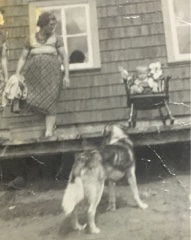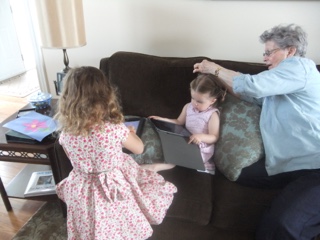Eleanor Bursey Gallant's parents, Jack Bursey and Julie Maurice Bursey, were both from St. Augustine, on the Lower North Shore of Québec. This is where they met, married in 1930 and had their family. The people on the lower north shore were self sufficient people. The Burseys did everything for themselves, without any social safety nets that people have today, such as welfare, pensions, old age security, or employment insurance. The men fished, hunted, sealed, trapped, cut wood, built what was needed. The women sewed, knit, hooked rugs, cleaned, washed, cooked and baked, raised children, all without the benefit of electricity or running water.
Sometimes the hard work took a tragic toll on the people. Such was the case for Jack's father, Reuben, who died tragically when he was hit in the head by a piece of wood. A block and tackle gave way as he and a group of men hauled a boat ashore. He was only fifty-nine.
Neither Jack or Julie had any schooling but were educated to survive life on the coast. As children, they were taught to do the practical things and co-operate with the rest of the community. Everyone learned the basics of survival, and if anyone was in need, others helped out. People relied on each other.
One of the most important people in the community was the midwife. There were no medical services, no doctor, nor any quick way to be extracted from the community in an emergency. The midwife was a crucial part of surviving life along the coast. The Burseys alone had sixteen children and Julie had two miscarriages as well. Occasionally, a tragedy occurred, such as happened with Julie's youngest sister. She needed a Caesarian section which the midwife could not provide, so both mother and baby died. However, the midwife delivered the biggest baby on the coast, at fifteen pounds, to Julie's brother and his wife.
The Burseys, like so many families of that time, lost four children when they were young. Lila died of pneumonia, Ashley died of brain cancer, Mary, a twin, died in infancy and Janet died of rabies. The tragedy of rabies was not as common as the other causes of death. However, it was common for animals to have rabies and people speculated that an infected animal was on the bridge of the Bursey home and Janet picked up the virus that way. There was nothing anyone could have done for Janet in those days and it was a horrible death for the young child. It must have been devastating for Jack and Julie to watch their little one suffer and die as she did.
St. Augustine is on the St. Augustine River, which flows into the Gulf of St. Lawrence. The settlement is near the mouth of the river; the salinity of the water lapping the shores of the community is affected by the tides. High tide brings salty sea water from the gulf into the river. The people only collected drinking water at low tide, when its salinity level was low.
This prospect was trickier in winter when the river iced over. Then, residents loaded a barrel on a komatic and a dog pulled it to the river at low tide. Through a hole in the ice, people dipped water in buckets into the barrel. The hole used for water retrieval was then covered for safety. Procuring water was a big part of life in the community.
One can imagine the work required to wash a man's work clothes as well as the amount of clothes for such large families. All the water was hauled from the river, clothes washed with lye soap, in a pan with a scrub board. Women were strong as a result.
Imagine the amount of food that the women cooked on wood stoves, all year long. They used ashes from the stoves as a leaven for bread. The family spread molasses on that bread and sweetened tea and porridge with it as well.
A band of Montagnais lived across the River at St. Augustine. They bartered with the villagers on the other side of the river, and both peoples came to rely on each other. They exchanged tents and seal skins for rough grub such as flour and potatoes. The barter system worked well for both groups.
Julie made seal skin boots for her family but she was very talented at upholstery as well. She could turn her hand at almost anything, even making a couch. Jack cut the wood from her pattern and she finished it.
Jack was talented as well. He made galvanized stoves, cut hair, and repaired shoes for the community. He made marbles for his children out of zinc and skates out of barrel stays which he sharpened on one side and attached the other to their boots. Jack also extracted the core from boils for ailing people by twisting a piece of wool over the boil.
Jack fished, hunted, and sealed but he also worked checking the telegraph line in later years, and as the janitor in the school. He did every job that came his way to support his family.
The Burseys, Jack and his brother Dan, had what they called a factory. Here, during the months of June to August, they canned salmon and trout for the next year. The factory was big enough for the men and their wives to steam the cans, cooking the salmon. They sold much of their product to The Hudson's Bay, keeping some for themselves at the end of the season. The children sat for hours shining the cans for the Bay.
There was some time for fun however. Jack was musical, played the accordion and the spoons. For a time, one of his brother's, Harold, lived in Spoon Cove, which was an hour from St. Augustine by boat. In winter, the Burseys went to visit Harold on komatic, with the older people sitting on the sleigh with the sides built up so as to be more comfortable.
In Spoon Cove, the furniture was pushed aside in someone's house and people danced. Jack sang too and told stories that seemed to lengthen with each telling.
Sadly, Julie died from pancreatic cancer in her late fifties. Jack lived to be ninety-two. They were hard working people who survived in a sometimes harsh but always beautiful environment. Jack and Julie experienced terrible tragedy, then did what had to be done for the rest of their children. The Burseys were resourceful, talented, spirited people. Theirs is a truly Canadian story and a great way to commemorate Canada Day.
To be continued...
Thank you to Eleanor Bursey Gallant for the pictures and the information.



















































